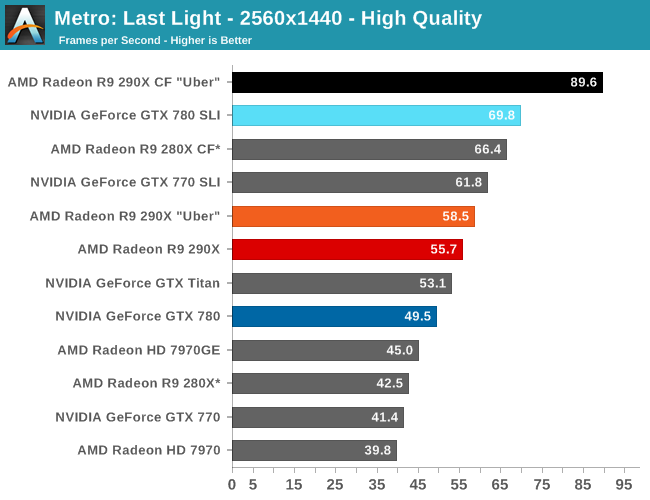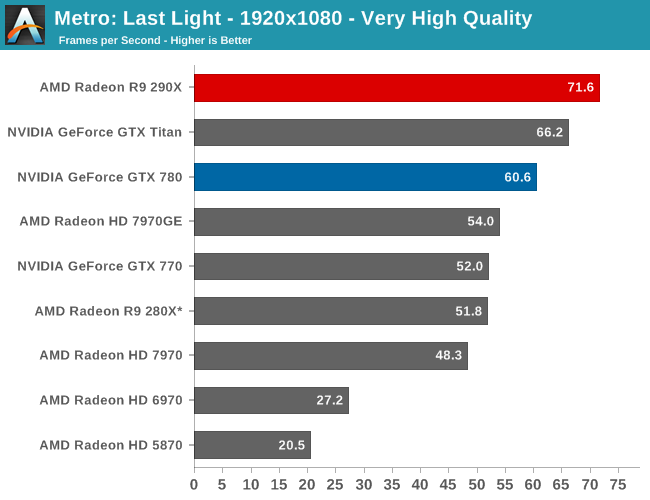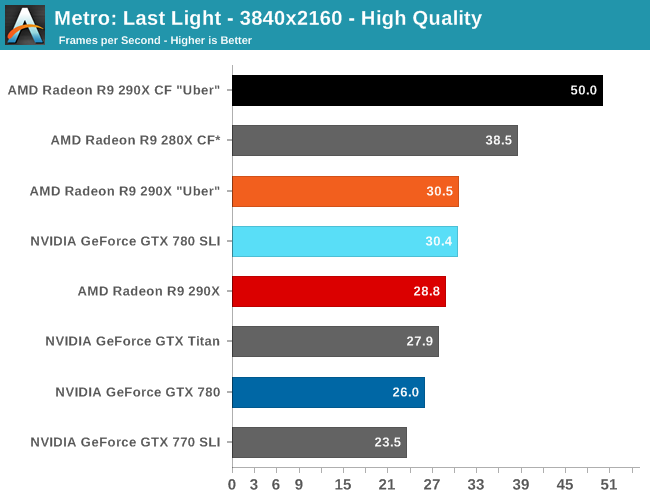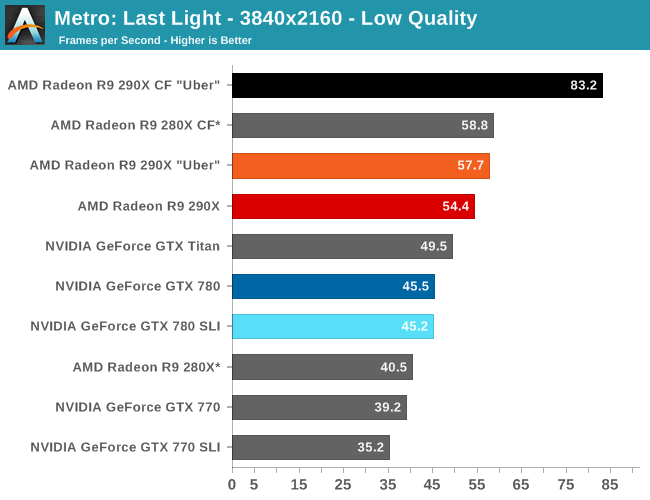The AMD Radeon R9 290X Review
by Ryan Smith on October 24, 2013 12:01 AM EST- Posted in
- GPUs
- AMD
- Radeon
- Hawaii
- Radeon 200
Metro: Last Light
As always, kicking off our look at performance is 4A Games’ latest entry in their Metro series of subterranean shooters, Metro: Last Light. The original Metro: 2033 was a graphically punishing game for its time and Metro: Last Light is in its own right too. On the other hand it scales well with resolution and quality settings, so it’s still playable on lower end hardware.


For the bulk of our analysis we’re going to be focusing on our 2560x1440 results, as monitors at this resolution will be what we expect the 290X to be primarily used with. A single 290X may have the horsepower to drive 4K in at least some situations, but given the current costs of 4K monitors that’s going to be a much different usage scenario.
With that said, for focusing on 4K on most games we’ve thrown in results both at a high quality setting, and a lower quality setting that makes it practical to run at 4K off of a single card. Given current monitor prices it won’t make a ton of sense to try to go with reduced quality settings just to save $550 – and consequently we may not keep the lower quality benchmarks around for future articles – but for the purposes of looking at a new GPU it’s useful to be able to look at single-GPU performance at framerates that are actually playable.
With that said, starting off with Metro at 2560 the 290X hits the ground running on our first benchmark. At 55fps it’s just a bit shy of hitting that 60fps average we love to cling to, but among all of our single-GPU cards it is the fastest, beating even the traditional powerhouse that is GTX Titan. Consequently the performance difference between 290X and GTX 780 (290X’s real competition) is even greater, with the 290X outpacing the GTX 780 by 13%, all the while being $100 cheaper. As we’ll see these results are a bit better than the overall average, but all told we’re not too far off. For as fast as GTX 780 is, 290X is going to be appreciably (if not significantly) faster.
290X also does well for itself compared to the Tahiti based 280X. At 2560 the 290X’s performance advantage stands at 31%, which as we alluded to earlier is greater than the increase in die size, offering solid proof that AMD has improved their performance per mm2 of silicon despite the fact that they’re still on the same 28nm manufacturing process. That 31% does come at a price increase of 83% however, which although normal for this price segment serves as a reminder that the performance increases offered by the fastest video cards with the biggest GPUs do not come cheaply.
Meanwhile for one final AMD comparison, let’s quickly look at the 290X in uber mode. As the 290X is unable to sustain the power/heat workload of a 1000MHz Hawaii GPU for an extended period of time, at its stock (quiet settings) it has to pull back on performance in order to meet reasonable operational parameters. Uber mode on the other hand represents what 290X and the Hawaii can do when fully unleashed; the noise costs won’t be pretty (as we’ll see), but in the process it builds on 290X’s existing leads and increases them by another 5%. And that’s really going to be one of the central narratives for 290X once semi-custom and fully-custom cards come online: Despite being a fully enabled part, 290X does not give us everything Hawaii is truly capable of.


Moving on, let’s talk about multi-GPU setups and 4K. Metro is a solid reminder that not every game scales similarly across different GPUs, and for that matter that not every game is going to significantly benefit from multi-GPU setups. Metro for its part isn’t particularly hospitable to multi-GPU cards, with the best setup scaling by only 53% at 2560. This is better than some games that won’t scale at all, but it won’t be as good as those games that see a near-100% performance improvement. Which consequently is also why we dropped Metro as a power benchmark, as this level of scaling is a poor showcase for the power/temp/noise characteristics of a pair of video cards under full load.
The real story here of course is that it’s another strong showing for AMD at both 2560 and 4K. At 2560 the 290X CF sees better performance scaling than the GTX 780 SLI – 53% versus 41% – further extending the 290X’s lead. Bumping the resolution up to 4K makes things even more lopsided in AMD’s favor, as at this point the NVIDIA cards essentially fail to scale (picking up just 17%) while the 290X sees an even greater scaling factor of 63%. As such for those few who can afford to seriously chase 4K gaming, the 290X is the only viable option in this scenario. And at 50fps average for 4K at high quality, 4K gaming at reasonable (though not maximum) quality settings is in fact attainable when it comes to Metro.
Meanwhile for single-GPU configurations at 4K, 4K is viable, but only at Metro’s lowest quality levels. This will be the first of many games where such a thing is possible, and the first of many games where going up to 4K in this manner further improves on AMD’s lead at 4K. Again, we’re not of the opinion that 4K at these low quality settings is a good way to play games, but it does provide some insight and validationg into AMD’s claims that their hardware is better suited for 4K gaming.










396 Comments
View All Comments
DMCalloway - Thursday, October 24, 2013 - link
Once again, against the Titan it's $450 cheaper, not $100. Against the gtx 780 it is a wash on performance at a cheaper price point. Eight months late to the game I'll agree on, however it took time to get in bed with Sony and Micro$oft which was needed if they (AMD) ever hope to get to the point of being able to release 'at a competitive time'. I'm amazed that they are still viable after the financial losses they suffered with the whole Intel paying OEM's to not release their current cpu gen. along side AMD's business . Sure, AMD won the law suit but the financial losses in market share was in the billions , Intel jumped ahead a gen. and the damage was done. Realistically, I believe AMD chose wisely to focus on the console market because the 7970ghz pushed hard wasn't really that far behind a stock gtx780.Bloodcalibur - Thursday, October 24, 2013 - link
Ever wonder why the TItan costs $350 more than their own GTX 780 while having only a small margin of improvement?Oh, right, compute performance.
anubis44 - Thursday, October 24, 2013 - link
and in some cases, the R9 290X is as much as 23% faster in 4K resolution than the Titan, or in the words of HardOCP: : "at Ultra HD 4K it (R9 290X) just owns the GeForce GTX TITAN."Bloodcalibur - Thursday, October 24, 2013 - link
Once again, Titan is a gaming/workstation hybrid, that's why it costs $350 more than their own GTX 780 with only a small FPS improvement in gaming.TheJian - Friday, October 25, 2013 - link
Depends on the games chosen. For instance All 4K:Guru3d:
Tombraider tied 4k 40fps (they consider this BARELY playable-though advise 60fps)
MOH Warfighter Titan wins 7%
Bioshock Infinite Titan wins 10% (33fps to 30, but again not going to be playable min in teens?)
BF3 TIE (32fps, again avg, so not playable)
The only victory at 4K is Hitman absolution here. So clearly it depends on what your settings are and what games you play. Also note the fps at 4K at hardocp. They can't max settings and every game is a sacrifice of some stuff (or a lot). Even at 2560 Kyle notes all were unplayable with everything on with avg's at 22fps and mins 12fps for all 3 basically...ROFL. How useful is it to win (or even lose) at a res you can't play at?
http://www.techpowerup.com/reviews/AMD/R9_290X/24....
Techpowerup tests all the way to 5760x1080, quoting that unless not tested. Here we go again...LOL
World of Warcraft domination for 780 & Titan (over 20% faster on titan 5760!)
SKYRIM - Both Titan and 780 win 5760
Starcraft2 only went to 2560 but again clean sweep for 780/Titan bot over 10%
Splintercell blacklist clean sweep at 2560 & 5760 for Titan AND 780 (>20% for titan both res)
Farcry3 (titan and 780 wins at 5760 but at 22fps who cares...LOL but 10% faster than 290x)
black ops 2 (only went to 2560, but titan wins all res)
Metro TIE (26fps, again neither playable)
Crysis 3 Titan over 10% win (25fps vs. 22, but neither playable...LOL)
At hardocp, metro, tombraider, bf3, and crysis 3 were all UNDER 25fps min on both cards with most coming in at 22fps or so on both. I wish they would benchmark at what they find is PLAYABLE, but even then I'm against 4K if I have to turn all kinds of stuff off in the first place. Only farcry3 was tested at above 30fps...LOL. You need TWO cards for 4K gaming. PERIOD. If you have the money to buy a 4K monitor or two monitors you probably have the cash to do it right and buy 2 cards. Steampowered survey shows this as most have 2 cards above 1920x1200! Bragging about 4K gaming on this card (or even titan) is ridiculous as it just ends up in an exercise of turning crap off that devs wanted me to SEE. I wouldn't care if 290x was 50% faster than Titan if you're running 22fps who cares? Neither is playable. You've proven NOTHING. If we jump off a 100 story building I'll beat you to the bottom...Yeah but umm...We're both still dead right? So what's the point no matter who wins that game?
Funfact: techspot.com tombraider comment (2560/1080p both tested-4xSSAA+16af)
"We expected AMD to do better in Tomb Raider since they supported the title's development, but the R9 290X was 12% slower than the GTX Titan and 3% slower than the GTX 780"
LOL. I hope they do better with BF4 AMD enhancements. Resident Evil 6 shows titan win also.
http://www.techspot.com/review/727-radeon-r9-290x/...
Tomshardware 4K quote:
"In Gaming At 3840x2160: Is Your PC Ready For A 4K Display?, I concluded that you’d want at least two GeForce GTX 780s for 4K. And although the R9 290X is faster than even the $1000 Titan, I maintain that you need a pair in order to crank your settings up to where they should be."
That was their ARMA quote...But it applies to all 4K...TWO CARDS. But their benchmarks are really low compared to everyone else for Titan in the same games. It's like took 10-15% off Titan's scores. IE, Bioshock infinite at guru3d shows titan winning 10%, but at toms losing by 20% same game, same res...WTF? That's odd right? Skyrim shows NV domination at 4k (780 also). Almost 20% faster for Titan & 780 (they tied) over Uber. Of course they turned off ALL AA modes to get it playable. Again, you can't just judge 4K by one site's games. Clearly you can find the exact opposite at 4K and come back down to reality (a res you can actually play at above 30fps) and titan is smacking them in a ton of games (far more wins than losses). I could find a ton more if needed but you should get the point. TITAN isn't OWNED at 4K and usually when it is as toms says of Metro "the win is largely symbolic though", yeah at 30fps avg it is pointless even turned down!
bronopoly - Thursday, October 24, 2013 - link
Why shouldn't one of the cards you mentioned be bought for 1080p? I don't know about you, but I prefer to get 120 FPS in games so it matches my monitor w/ lightboost enabled.Bloodcalibur - Thursday, October 24, 2013 - link
Except the Titan is a gaming/workstation hybrid due to its computing ability. Anyone who bought a Titan just for gaming is retarded and paid $350 more than they would have on a 780. Titan shouldn t be compared to 290X for gaming. Its a good card for those who do both gaming and a little bit of computing.looncraz - Thursday, October 24, 2013 - link
Install a new cooler and the last two of those problems vanish... and you've saved hundreds... you could afford to build a stand-alone water-cooling loop just for the 290x and still have money to spare for a nice dinner.teiglin - Thursday, October 24, 2013 - link
I haven't finished reading the article yet, but isn't that more than a little hyperbolic? It just means NVIDIA will have to cut back on the amount it gouges for GK110. The fact that it was able to leave the price high for so long is nearly all good for them--it's just a matter of how quickly they adjust their pricing to match.It will be nice to have a fair fight again at the high-end for a single card.
bill5 - Thursday, October 24, 2013 - link
Heh, I'm the biggest AMD fanboy around, but these top two comments almost smell like marketing.It's a great card, and the Titan was deffo highly overpriced, but Nvidia can just make some adjustments on price and compete. That 780 Ti they showed will surely be something in that vein.